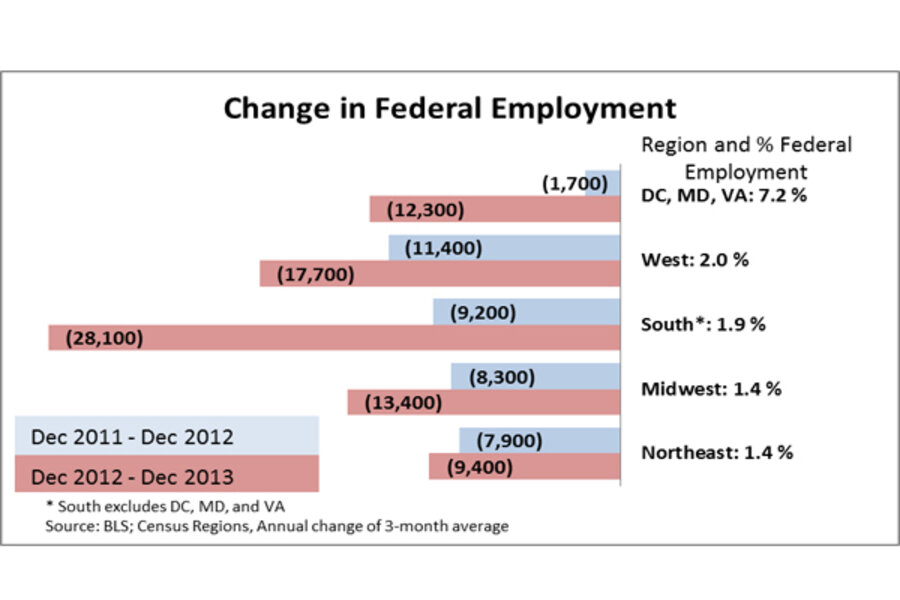Federal job cuts hit the South and West
Loading...
Government employment is down again. But while cuts in state and local jobs drove the decline in 2011 and 2012, the federal government is the culprit now. The federal workforce has decreased about 3 percent, or 75,000 positions, from last year. That’s in sharp contrast to the slightly positive growth (0.3 percent) for the state and local sector.
Overall, government employment has not grown for five years when you take out temporary workers hired to take the census in 2010. After this adjustment, there are 730,000 fewer government jobs since the peak in January 2009, with about 10 percent of the decline coming from federal employment and 90 percent from the state and local workforce.
Interestingly, many of the states taking the hardest hit from the loss of federal jobs were not in the DC area. By Census region, the biggest declines came in the south and west where federal employment makes up about 2 percent of total jobs. From December 2011 to December 2013, the federal workforce was cut by 37,300 in the South (chart). Many of the losses were in civilian defense jobs.
A great table in our last State Economic Monitor shows that only six states had no net loss of federal jobs: Idaho, New Hampshire, North Dakota, Utah, Vermont, and Wyoming.
Not surprisingly, California and Texas, the largest states, had the biggest decline in federal jobs in absolute terms.
But in terms of percent change, Alaska had the largest contraction, losing almost 8 percent of its federal workforce in December 2013 compared to a year ago. Others taking a big hit, declining by more than 4 percent: Arkansas, Kansas, Montana, New Jersey, and Washington.
None of the states in the Washington DC metro area are even in the top ten measured in terms of percentage losses: DC is 15th , Virginia 28th and Maryland 43rd . However, because the federal government makes up 28 percent of the workforce in D.C., a proportionately small decline in federal jobs translates to over 6,000 jobs.
Alaska is similar: Federal employment represented fully one-fourth of the total workforce, so the 1,200 jobs lost in December disproportionately affected the economy. The federal jobs also tended to be higher paying and more stable than other Alaskan work.
Although overall state and local employment increased in 2013, twenty-two states reported a decline from the prior year. This loss of human capital has already begun to affect government services, most alarmingly education, which accounted for 60 percent of the local government decline in employment from 2009 to 2013.
Thus while our economic monitor shows some cautious improvement in other employment indicators, declining public sector employment, particularly in the federal government, continue to drag down the recovery.







